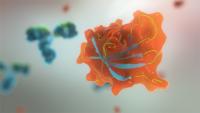A new review article published this week in New Biotechnology from authors at the University of Leeds details the current state of play of scaffold binding proteins, such as Affimer binders, in the field of cancer biology signalling. This review illustrates how these technologies have much to offer both research and industrial drug development pipelines, through their high target specificity, intracellular activity and capacity to modulate the function of individual protein domains without affecting protein expression.

The biological mechanisms underlying cancer include the ability of cancerous cells to sustain proliferation and resist cell death, whilst enabling replicative immortality and invading and metastasising to new sites. These cellular processes are governed by a complex variety of signalling networks within the cell, each of which is composed of a series of protein-protein interactions.
Individual proteins within any single signalling pathway likely possess multiple domains that can engage in different protein-protein interactions. The authors cite the example of the EGFR pathway that contains 375 proteins, but consists of over 1000 protein-protein interactions. Understanding these interactions would give increased insights for basic cancer biology and could create new therapeutics to combat these diseases.
Using traditional tools analysing intracellular signalling is very difficult: the reducing environment of the cell prevents the use of labelling reagents, such as antibodies, due to the presence of essential disulphide bridges within their structure; many of the interactions surfaces are large and consist of flat surfaces that are not often the target of small molecules; and highly homologous domains between protein family members can be difficult to specifically target with small molecules, leading to off-target effects.
In this review, the authors consider many of the different scaffold proteins that have been developed across the industry and targeted to a range of different cancer signalling molecules. They highlight the additional functionality of these scaffold binding proteins over other tools, being able to modulate target protein function, operate as intracellular biosensors, and work as imaging reagents.
Affimer technology has been applied to a number of relevant signalling interactions within this review.
The high level of target specificity achievable using Affimer binders is discussed, considering the specific Affimer proteins that target SH2-domains of Grb proteins. These domains exhibit up to 70% sequence identity and have proven difficult to target via other methods. Affimer binders were able to specifically isolate Grb proteins from cell lysates and are being explored for their potential intracellular activity.
Affimer proteins targeted to the regulatory p85 subunit of PI3-K, that functions in cell proliferation and survival, were able to inhibit the function of PI3-K without disrupting the protein complex formation. This property of scaffold proteins is likely to become important in dissecting some regulatory pathways.
Both sumoylated and ubiquitinated proteins have been implicated in cancer as they modify well-known tumour suppressors and oncogenes, such as mTOR and p53. A number of Affimer proteins targeting these post-translational modifications have been utilised, offering tools for the study of unique targets unavailable with other technologies or the ability to bind the post-translational modification target without inhibiting conjugation, whereas similar binders from other technologies were unable to show this.
The ability of scaffold binding proteins to specifically bind proteins of interest and modulate their function could allow researchers to delineate the function of protein-protein interactions across health and disease states. In this way they could act as potential new therapeutic molecules directly or reveal new therapeutic targets to pursue with traditional small molecules.